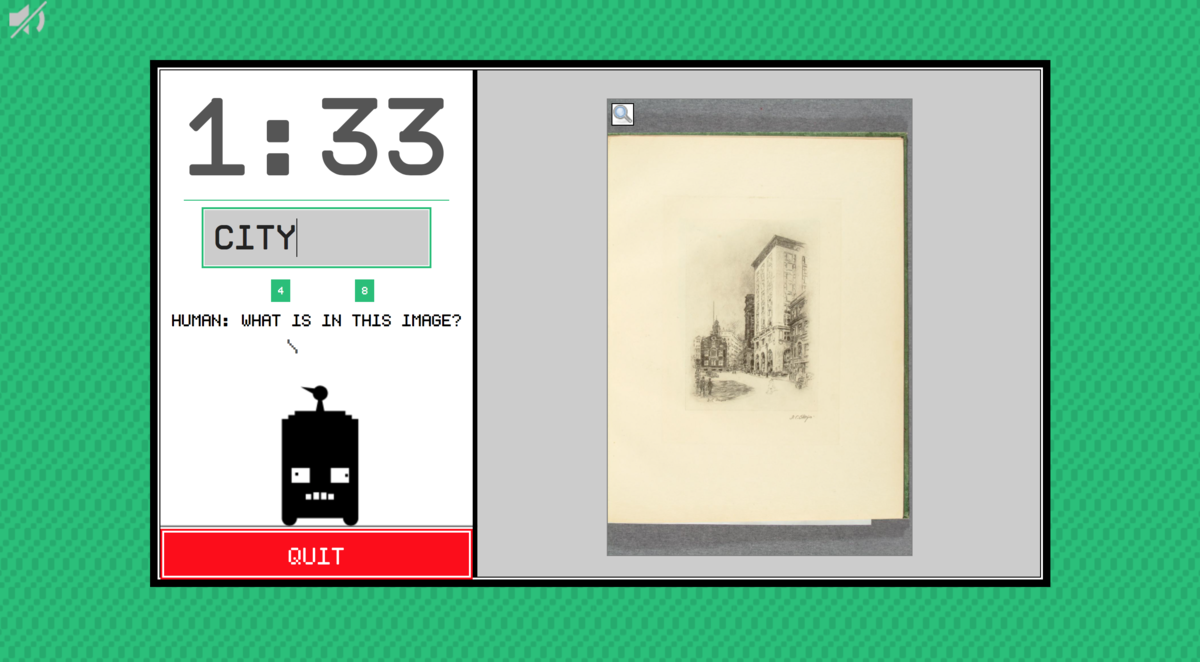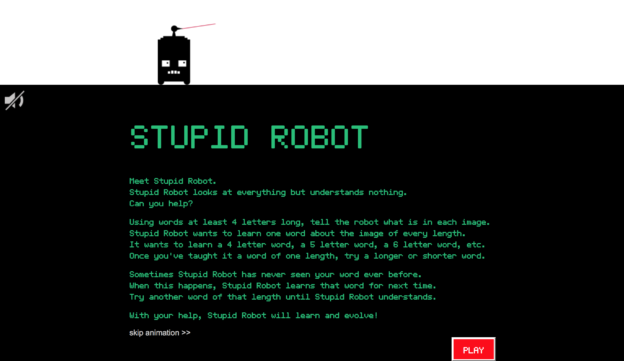The digital activism project that I recently contributed to through crowdsourcing was Stupid Robot by Metadata Games. Metadata Games emerged out of the Dartmouth College based game research laboratory Tiltfactor, whose chief objective is to design games for social impact and learning. Today, Metadata Games is the National Standard open source crowdsourcing game platform, comprised of more than forty-five collections from eleven institutions. The platform’s games have helped to generate over three thousand and fifteen tags for images, audio, and video items for various libraries and museums – British Library, Boston Public Library, the Open Parks Network, Digital Public Library of America, and the American Antiquarian Society chief among them. The National Endowment for the Humanities and the American Council of Learned Societies fund the project.
Stupid Robot is a simple arcade game that prompts players with an image, of which the player must then describe to a robot to teach it new words. The challenge confronting the player is twofold. First, words must be four-to-ten letters long. Second, the robot only understands words that other players have taught it.
Contributing data to the project was as easy as playing the game. After being presented with directions (see above thumbnail), I hit the play button and then was presented with the following screen:

Screenshot of game window.
I entered words in the textbox until the timer went out before being prompted to play again.
Each image is part of a libraries’ and museums’ digital collection. Consequently, teaching Stupid Robot words provides keywords for each photograph. Stupid Robot is not as stupid as you would think, however, as it requests words of different lengths as you progress, perhaps to generate as much tags as possible for each image.
While it is not obvious at first sight, Stupid Robot contributes to a larger purpose. Libraries and museums are struggling to digitally preserve image, audio, and media items vis-à-vis making them searchable on the World Wide Web. Stupid Robot mitigates that problem. It helps to catalogue libraries’ and museums’ media collections by prompting players to contribute descriptive tags for images, thus making them more accessible to libraries, researchers, and the public. The novelty of Stupid Robot is that it makes saving digital artifacts from being lost in time as easy as playing a simple arcade game.
Due to the game’s relative ease, Stupid Robot did not initially feel like digital activism. I felt like a was playing a challenging word game that aimed to get me to think more critically about visual interpretation and the myriad of ways I could describe the objects in a picture. The game helped me to see details in landscapes that I would not have otherwise noticed.
It was not until I read the game description and the mission statement of Metadata Games that I grasped the scope of Stupid Robot’s goal. I learned that by playing a video game, I could also be contributing data to various digital collections, both to make them more accessible and to keep them from being lost to time. Ultimately, playing Stupid Robot was a fulfilling experience that enabled me to have fun while also making an imapact!

One response to “Crowdsourcing – the Not So Stupid Bot”
According to this blog post, I can infer that crowdsourcing is using the general public to make contributions to a project. In this case it was by playing a game called Stupid Robot.
How do they get people to the site who are not in the feild of humanities?
How accurate are the tags that people who are playing the game are making? I know that when I was playing this game, I felt as though I was not able to come up with great tags.